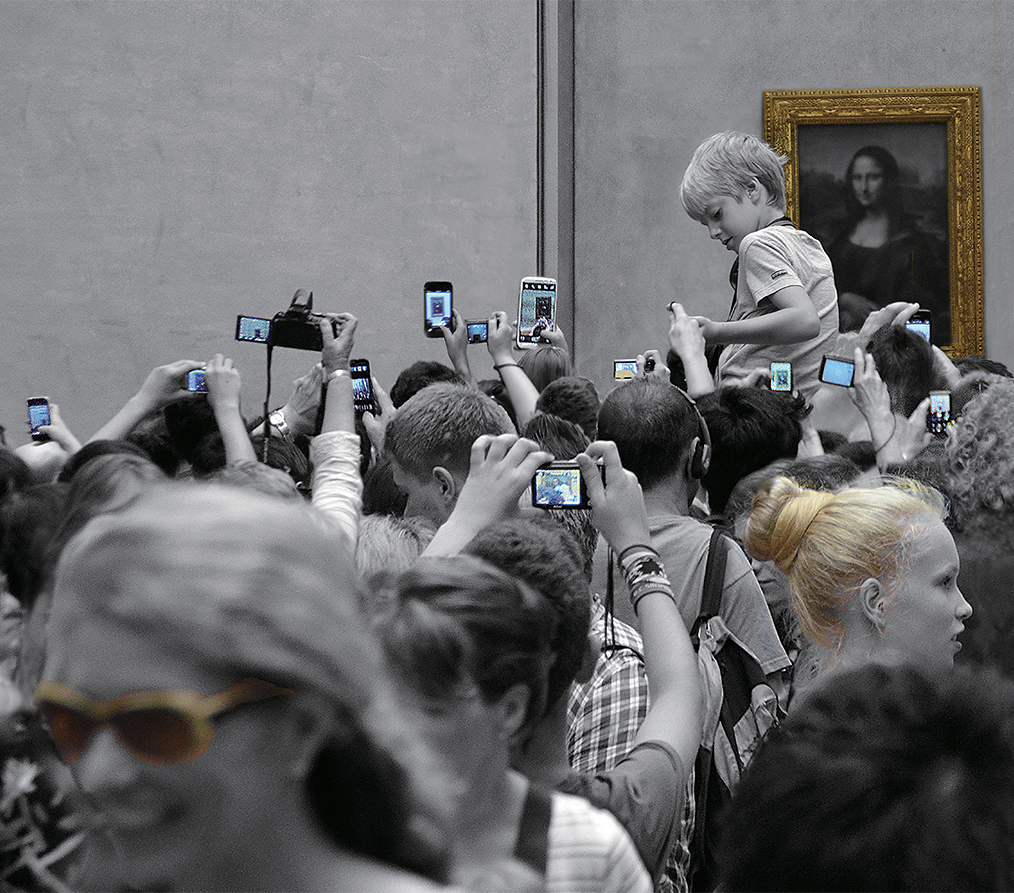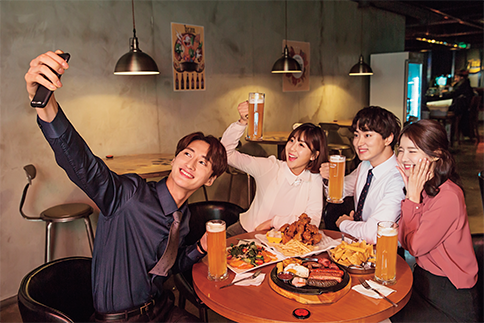The ubiquity of digital cameras and smartphones has redefined the role of photography: it is now a means to record everyday moments, not just special events, and a medium of communication readily available to anyone. Taking photos of one’s activities and instantly sharing them via social media has thus become a typical feature of everyday Korean life.

“Children Playing in the Alleyway Haengchon-dong, Seoul”
Kim Ki-chan, 1972. © Choi Gyeong-ja. Photo source: Noonbit Publishing Co.
Many people take pictures wherever they go these days. But why are they so engrossed in this activity? Perhaps it is because of their desire to remember and cherish particular moments. The act of taking pictures involves taking possession of such moments, for memories are, in a broader sense, also something that is possessed.
When a camera is pointed at them, elderly people often react by saying, “What’s the use of taking a picture of this old face?” This response suggests that they consider photography an art form inherently meant to serve an aesthetic purpose. Why do they think only beautiful things deserve to be photographed? Of course, few would try to capture unsightly s or ugly landscapes unless they are collecting ary materials or working with a special concept.

At Changgyeong Palace in Seoul, young women take selfies dressed up in traditional Korean attire. They are obviously more interested in obtaining special “proof shots” than appreciating the historic site.
© Chosun Ilbo
Getting That ‘Once in a Lifetime Shot’
After the advent of digital cameras, myriad amateur photographers have produced landscape photographs that are practically the same, like a series of prints. Again, the question is “Why?”
I once visited an old temple standing on the edge of a cliff, and was quite upset that the view was shrouded in thick fog. I said to myself, Oh, the temple should be photographed from here, from this exact angle! The pictures of the place that I’d seen in guide books lingered in my mind. I waited for a while, but the fog did not lift. Then my guide smiled and said, “I have a good idea. Try googling this place when you get back home.”
Countless tourists return from their travels with almost identical pictures of the places they visited because they are evidence of what they experienced or felt there. They probably waited in line to capture the same view in the same way. They believe that the beautiful scenery in front of their eyes can be “owned” by capturing it with their cameras, and they want others to recognize their “ownership.” Koreans coined a new term by referring to this kind of photo as injeung shot, meaning “proof shot,” which sociologists of the future might classify as a separate photography genre, like ary photos or portraits.

In a restaurant, young customers take a photo of themselves with the beers and food just served before drinking. Young people have d a new culture of taking photos of their everyday activities and sharing them via social media.
© GettyimagesBank
After homo faber, the human manufacturer of tools, homo habilis, the “handy man” or human manufacturer of stone tools, and homo ludens, the playful human being, the 2010s have brought us a new human who could be nicknamed homo Photocus. They are men and women of all ages, including many elderly people who some might not expect to feel all that comfortable with new technologies. But a smartphone camera, if not a digital single-lens reflex camera, can be handled with ease by anyone. Though small enough to be held in one hand, a smartphone can take any kind of picture; and on top of a selfie stick, it can snap photos from broad angles beyond the normal reach of the photographer’s arm, rendering it unnecessary to ask strangers for help.
The homo Photocus of the 21st century, hoisting a smartphone aloft and preoccupied with taking “proof shots,” has spread all over the world. In the era of digital cameras, smartphones and social media, the “proof shot” may be the distinguishing characteristic of this new type of human being.
Over the last few years, a new phenomenon has emerged that one can witness in the heart of Seoul around its royal palaces and traditional neighborhoods, such as Gyeongbok Palace and Bukchon, or even at the traditional Korean village in the city of Jeonju. At these famed cultural sites, young men and women, mostly in their teens and twenties, dress up in rented hanbok, traditional Korean attire, and take “proof shots.” Though the traditional dress has almost vanished from Koreans’ everyday lives, except for special occasions like weddings, it has now returned to the streets. Interestingly, however, this trend is not so much concerned with the revival of tradition or history, but with photography, pure and simple.
These young people photograph themselves in beautiful traditional attire, notably different from modern clothing, then upload the pictures instantly to their social media accounts to share them with real and virtual friends. The best among their “proof shots” is what they call insaeng shots, which loosely translates to “once in a lifetime shot.” In quest of that special shot, they roam fancy neighborhoods, royal palaces, famous cafés and tourist hotspots, wearing dazzling costumes.
The homo Photocus of the 21st century, hoisting a smartphone aloft and preoccupied with taking “proof shots,” has spread all over the world. In the era of digital cameras,
smartphones and social media, the “proof shot” may be the distinguishing characteristic of this new type of human being.
The Core of Communication
Photographs attract people. Internet posts that aren’t accompanied by pictures attract significantly fewer viewers. Therefore, bloggers and other media creators go to great lengths to upload striking pictures that will entice people to click on their links. This is especially true for media creators focusing on food or fashion, for which photos play a critical role. They are often equipped with high-performance digital cameras and skills measuring up to professional photographers.
Digital cameras and smartphones have brought a great change in how photography is used in everyday life. In the analog age, people would take pictures and have them printed and framed to hang on the wall or place on a dresser or desk. Every now and then, they would look at them, recalling the time and people in the pictures. In today’s digital age, however, taking the photo marks just the beginning; what follows is a long process of selecting good shots, deleting bad ones, processing the selected ones with photo editing software, and uploading them on social media. Only rarely does a completed photo end up in a frame on the wall. Most are uploaded on the Internet to be shared and spread throughout the virtual world.
Pictures posted on social media usually receive a fair share of comments from others expressing their approval or criticism. In the past, only one’s family and friends may have expressed their opinions about a photo. Now, however, even complete strangers may comment on others’ photos, and the fate of a digital picture is determined by how well it is edited and how many “likes” it receives on social media sites.
Based on my observations, the social media posts that attract the greatest response are not those discussing political or social issues, or even personal matters, but selfies and “proof shots.” These photographs tend to move a larger number of people, leading even the most reticent to leave a comment. Pictures, more than writing, are likely to elicit emotional responses from people, encouraging them to check in on and share stories with one another; in short, they motivate people to interact intimately with others. Riding on the wings of social media, photography in the digital age has perhaps become the most useful means of communication.

Sehwa Beach on Jeju Island always bustles with couples and honeymooners taking photos against its beautiful seascape. People’s wishes to capture special moments of their lives in photos and share them on social media have turned every hidden corner of the island into a celebrated tourist attraction. © jejuguree
Proof of Desires, Not of Facts
More photographs have probably been taken in the 2010s alone than over the past 180 years since the invention of the camera. Undoubtedly, technological progress has made this possible, but underlying this phenomenon is the fact that photography in the digital era reflects our desires. In his book “Trend Korea,” Kim Ran-do, professor of consumer science at Seoul National University, claimed that “addiction to evidence” and “daily boasting” were some of the top trends witnessed in Korea in 2015. It means we are living in an era of suspicion, where we hardly believe anything without evidence, acknowledging only what can be seen and proved. According to the author’s analysis, in a world where “retweets” and “likes” on social media speak for individual identity, boasting has become routine.
In this age of self-verification, “proof shots” are undeniably a powerful tool. But something is amiss here. Proof, in the proper sense of the word, should be faithful to the truth, so anything disagreeing with fact cannot be proof. However, “proof shots” are true and false at the same time because selfies, for example, that are edited or beautified are not an exact reflection of the person but an ideal removed from reality. There are countless smartphone apps that make people look nicer, erasing wrinkles, softening skin tones, or enlarging eyes. It’s ironic that these images, taken out of context and edited to look better, are being used for self-verification.
For ages, people have used photographs to “prove” their identity. Now, however, pictures on a driver’s license or job application might be useless in that sense. At least in Korea, hardly anyone uses unedited photos these days. Glamorized selfies and “proof shots” are not evidence of people’s identities, but of their desires, showing not who they are, but what they wish to be. After all, ceaselessly raising your smartphone to take a “proof shot” is an effort to have your desires recognized by others. This is an era of contradiction, where people want to be acknowledged by the multitude while having little faith in others and making less and less effort to communicate with them. Photography in the digital age points to the duplicity of our existence.
Choi Hyun-juFreelance Copywriter; Photo Essay